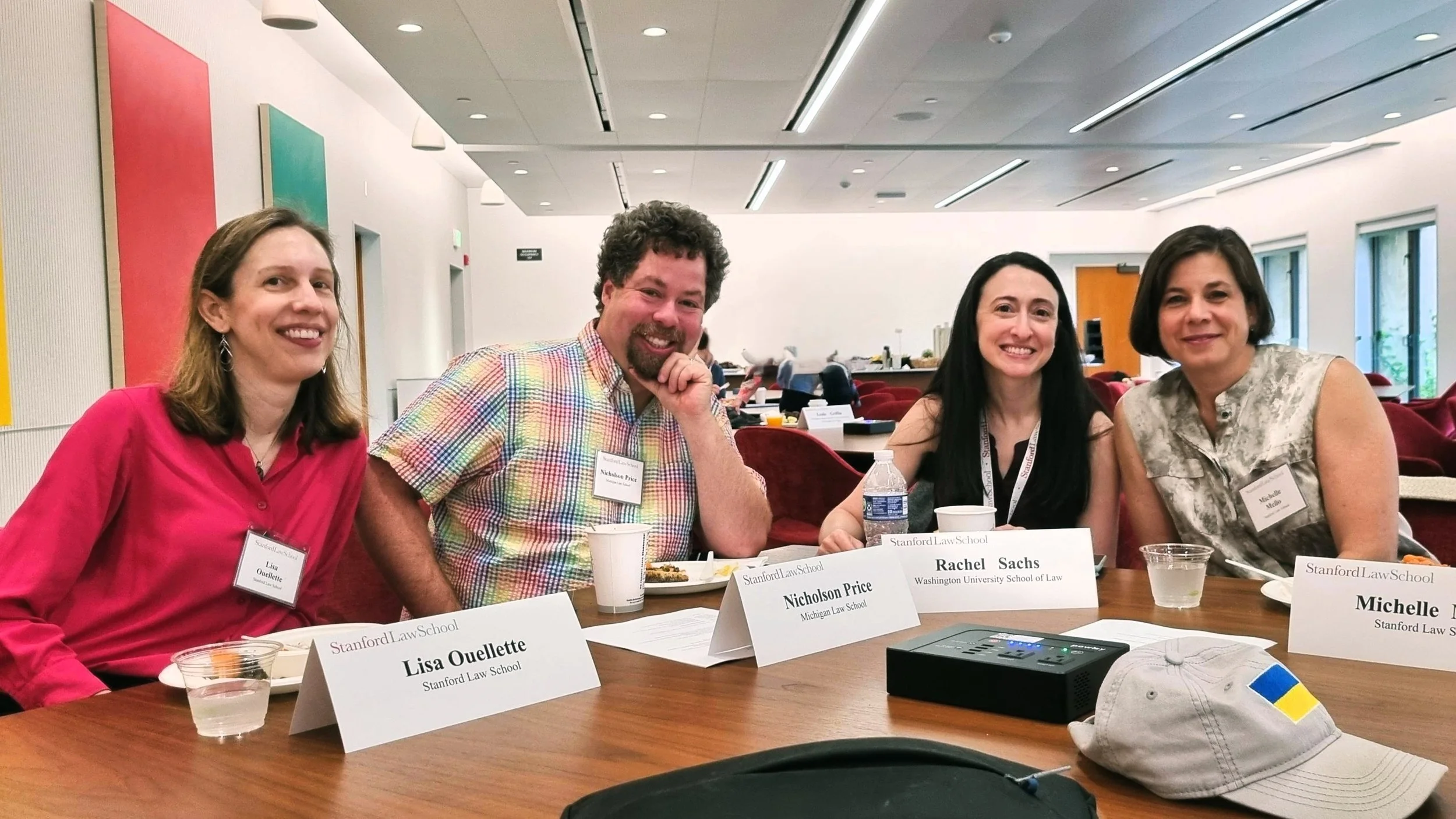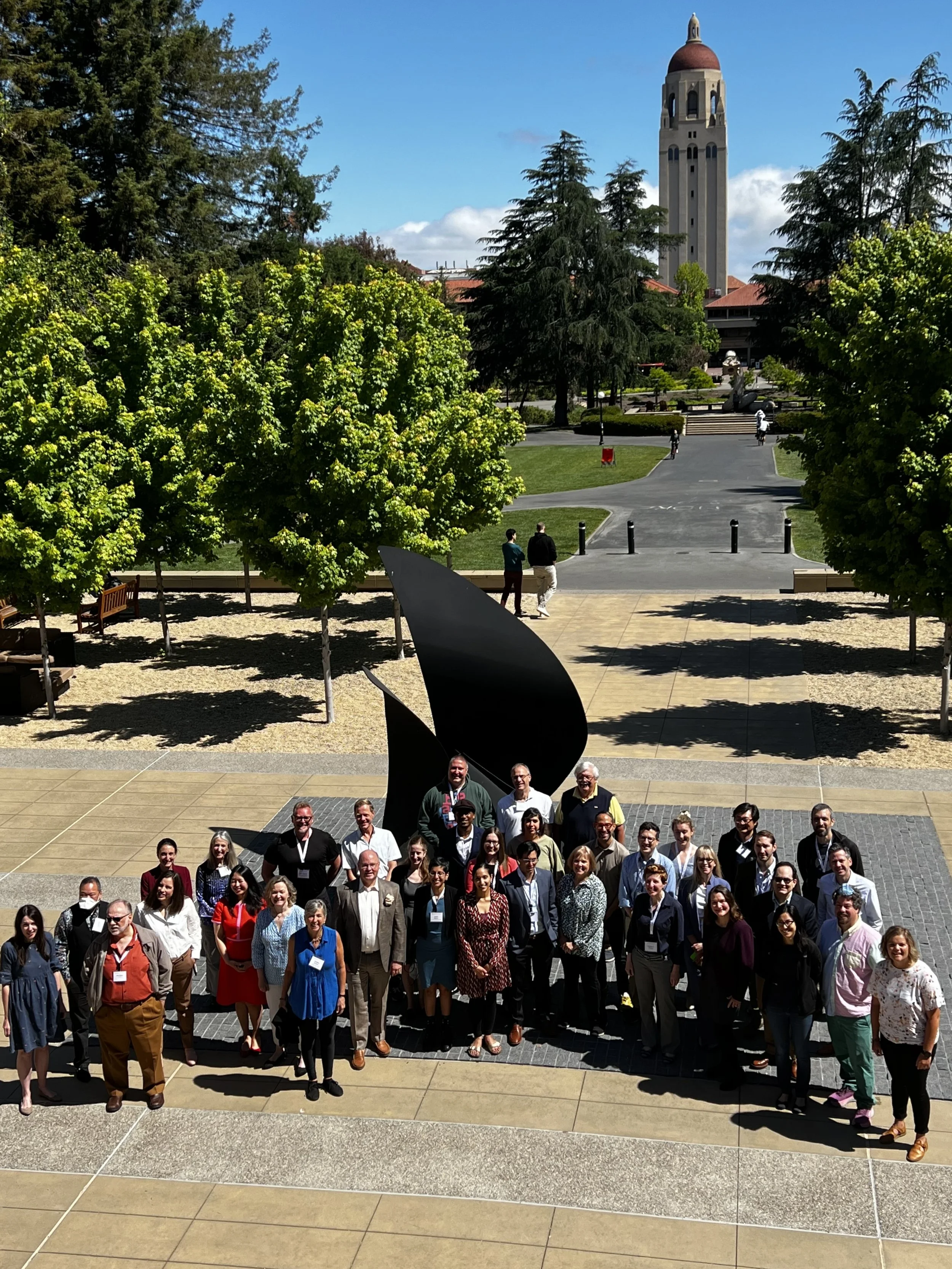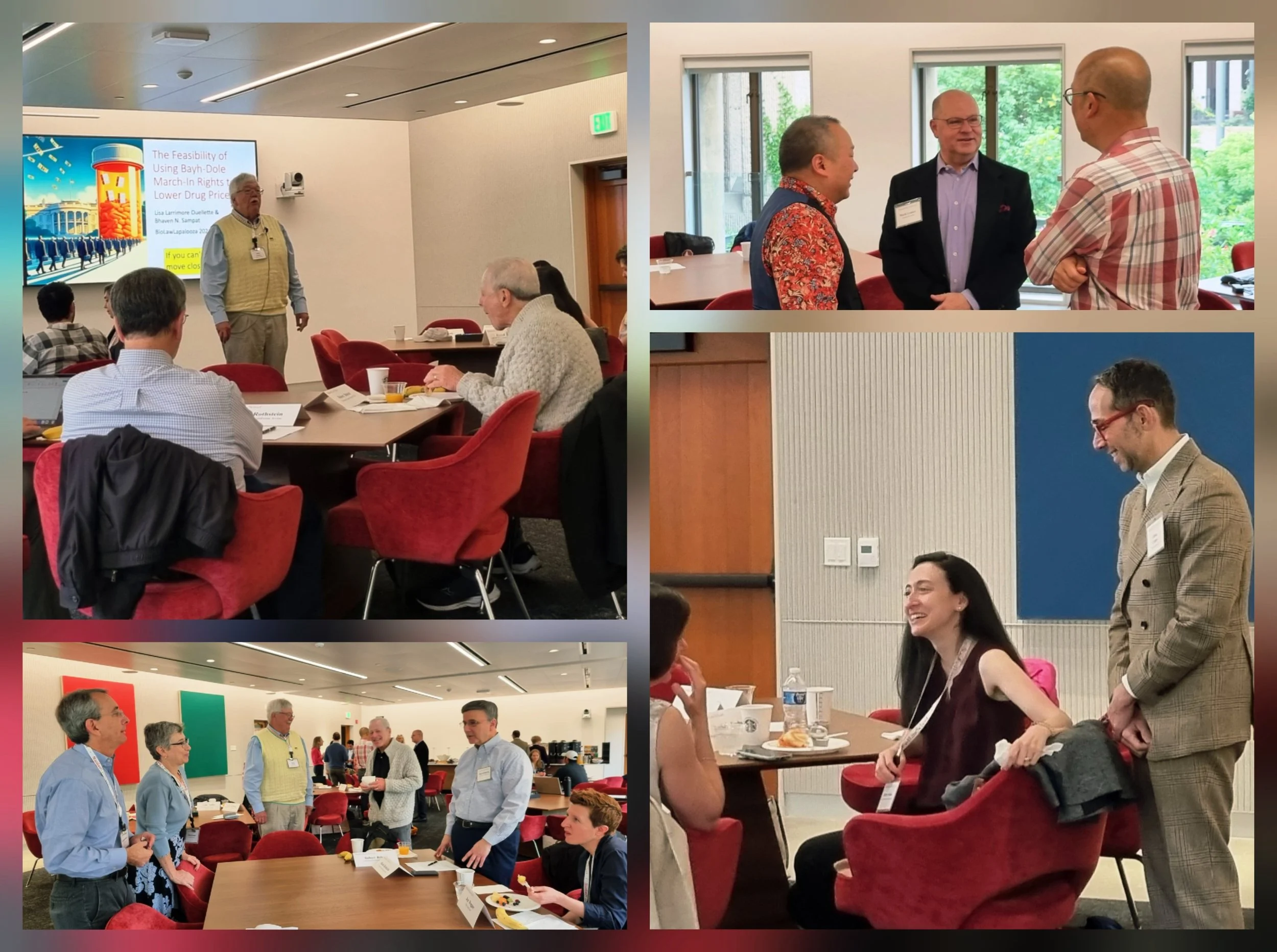Stanford Center for Law and the Biosciences: BioLawLaPaLooZa 2023-2024
For those deeply engaged in the intricate intersections of law, life sciences, and ethics, Professor Hank Greely’s annual BioLawLaPaLooza at Stanford Law School stands as an intellectual cornerstone. It is a vibrant, informal, yet deeply substantive gathering that brings together leading scholars to test new ideas, debate emerging challenges, and build the collaborative bridges essential for navigating our complex technological future. As a speaker and the photographer for the 2023 and 2024 editions, Stanford Center for Responsible Quantum Technologie Founder Mauritz Kop had the distinct pleasure of documenting and participating in these vital conversations. This post offers a reflection on and tribute to these remarkable events, which serve as a testament to the foresight and community-building spirit of Stanford’s Center for Law and the Biosciences.
Stanford Center for Law and the Biosciences: BioLawLaPaLooZa 2023-2024. Pictures by Mauritz Kop
The Center for Law and the Biosciences (CLB): A Foundation for Interdisciplinary Dialogue
Before delving into the events themselves, it is essential to understand the institution that makes them possible. The Stanford Center for Law and the Biosciences (CLB), under the direction of Hank Greely, has long been a preeminent academic hub for exploring the legal and ethical quandaries posed by advances in the life sciences. Alongside the Petrie-Flom Center for Health Law Policy, Biotechnology, and Bioethics at Harvard University, directed by Professor I. Glenn Cohen, the CLB stands as one of the world's leading institutions in this domain. The Center's mission is to foster interdisciplinary research, educate the next generation of leaders in law and science, and inform public policy on topics ranging from genetics and neuroscience to reproductive technologies and AI in healthcare.
The CLB's history is marked by influential scholarship, a distinguished roster of fellows and faculty, and a commitment to public engagement. Its fellowship program has proven to be a successful launchpad, with former fellows frequently securing positions as professors and becoming influential scholars in their own right. Its publications consistently shape academic discourse and provide critical guidance to policymakers. BioLawLaPaLooza is the embodiment of the Center’s mission, creating an environment where complex ideas can be presented and scrutinized in a collegial, fast-paced format. The event’s structure—short, sharp presentations followed by engaged discussion—ensures a breadth and depth of intellectual exchange that is both rare and invaluable.
Professors Lisa Ouellette, Nicholson Price, Rachel Sachs and Michelle Mello.
The Journal of Law and the Biosciences: A Premier Scholarly Venue
Further extending the intellectual ecosystem of which the CLB is a part is the Journal of Law and the Biosciences (JLB). As the first peer-reviewed academic journal focused on the intersection of law and the life sciences, JLB serves as the premier venue for scholarship in this field. It is a co-publication of Duke University, Harvard University Law School, and Stanford University, published by Oxford University Press. The journal's leadership reflects the collaborative and interdisciplinary spirit of the field, with Editors-in-Chief Professor Nita Farahany (Duke), Professor I. Glenn Cohen (Harvard), and Professor Hank Greely (Stanford). Many of the scholars who present their nascent ideas at BioLawLaPaLooza are also contributors to and readers of the journal, highlighting the symbiotic relationship between the conference and the formal academic literature. https://academic.oup.com/jlb
The journal of Law and the Biosciences is published by Oxford Academic.
A Hub for Prolific Scholarship
The intellectual vitality of the CLB and Petrie-Flom communities is further evidenced by their extensive scholarly output. Mauritz Kop, Suzan Slijpen, I. Glenn Cohen, and their co-authors have published numerous pieces on the centers' respective Bill of Health and Law and Biosciences blogs, tackling the regulatory and ethical frontiers of AI, quantum technology, and healthcare. These works include:
EU and US Regulatory Challenges Facing AI Health Care Innovator Firms: This article analyzes the differing regulatory landscapes for AI in healthcare in the European Union and the United States. It highlights the significant hurdles innovator firms must navigate, including issues of data privacy, algorithmic accountability, and conformity assessments under frameworks like the EU AI Act. Read more at Stanford: https://law.stanford.edu/2024/04/06/eu-and-us-regulatory-challenges-facing-ai-health-care-innovator-firms/
Safeguards for Accelerated Market Authorization of Vaccines in Europe: Examining the European Medicines Agency's response to the COVID-19 pandemic, this piece details the regulatory mechanisms for accelerating vaccine approval. It underscores the critical importance of robust post-market surveillance and transparency to maintain public trust while ensuring rapid access to essential medicines. Read more at Stanford: https://law.stanford.edu/2021/03/15/safeguards-for-accelerated-market-authorization-of-vaccines-in-europe/
How Quantum Technologies May Be Integrated into Healthcare: What Regulators Should Consider: This work outlines the transformative potential of quantum technologies—from advanced sensing for diagnostics to quantum computing for drug discovery. It calls for a proactive regulatory approach to address the unique challenges these technologies pose to safety, efficacy, and equity in healthcare. Read more at Harvard: https://hls.harvard.edu/bibliography/how-quantum-technologies-may-be-integrated-into-healthcare-what-regulators-should-consider/
A Brief Quantum Medicine Policy Guide: Serving as a concise primer for policymakers, this article provides a high-level overview of the key considerations for integrating quantum technologies into clinical practice. It touches on the need for new standards, ethical guidelines, and regulatory frameworks to ensure the responsible development and deployment of quantum medicine. Read more at Harvard: https://petrieflom.law.harvard.edu/2024/12/06/a-brief-quantum-medicine-policy-guide/
Prof. Greely in conversation with Prof. Cohen during the reception of Stanford RQT 1.0, May 22, 2023.
BioLawLaPaLooza 5.0 (May 19-20, 2023): Navigating the Frontiers of Law and Biology
The 2023 edition of BioLawLaPaLooza set a high bar, with a series of panels that spanned the most pressing issues at the nexus of law and biology. The Manning Faculty Lounge was filled with an electric energy as experts presented on topics including reproductive rights, the legal implications of neuroscience, the regulation of medical data, and intellectual property challenges in biotechnology.
Distinguished scholars offered incisive analyses on a wide range of subjects. Presentations included Michelle Obermann on Doctors’ Role in the Battle Over Abortion Information, Lewis Grossman on the path to over-the-counter abortion pills, and Teneille Brown on the dynamic of "When Doctors Become Cops." The program also featured Michelle Mello discussing data sharing between academic medical centers and tech companies, Dorit Reiss on the CDC's role in combating anti-vaccine misinformation, and Nicholson Price on government data as a form of AI regulation. The IP & Innovation panel featured thought leaders like Mark Lemley, who presented an analysis of potentially illegal interlocked boards in life science companies, and Jake Sherkow, who explored "The Myth of Genomic Trade Secrecy."
Prof. Mark Lemley presents his Interlocking Directorates in Life Science Companies project. Mauritz Kop presents his Quantum Technology in Drug Design project. Prof. Andrew W. Torrence wears a BioLawLaPaLooZa fan sweater.
A Foray into Quantum Technology and Drug Discovery
It was on this IP & Innovation panel that Mauritz Kop presented his work on "Quantum Technology & Drug Discovery." The talk focused on three core themes. First, it outlined the profound impact that second-generation quantum technologies (QT) are poised to have on the pharmaceutical industry. By leveraging quantum simulation and quantum machine learning, QT promises to dramatically accelerate the drug discovery and design process, creating new dynamics for clinical trials, regulatory approval, and patent law.
Second, the presentation introduced the concept of Quantum-ELSPI—a research paradigm that expands the traditional Ethical, Legal, and Social Implications (ELSI) framework to explicitly include Policy and the geopolitical dimensions of this strategic technology. This is crucial because QT, much like AI and biotechnology, is a dual-use technology with significant national and economic security implications.
Finally, Kop proposed that the nascent field of quantum governance can and should learn from the successes and failures of regulation in the biosciences. Specifically, he suggested that frameworks for market authorization, such as those employed by the Food and Drug Administration (FDA) for novel drugs, could serve as valuable models for establishing certification and product safety regimes for high-risk quantum systems.
BioLawLaPaLooza 5.0 (May 19-20, 2023): Navigating the Frontiers of Law and Biology.
BioLawLaPaLooza 6.0 (May 17-18, 2024): Legal Dimensions of Healthcare & Life Sciences
Building on the momentum of the previous year, BioLawLaPaLooza 6.0 continued the tradition of rigorous intellectual exchange. The 2024 agenda was similarly packed with cutting-edge topics. The program once again featured a roster of leading thinkers. Professor Mark Lemley discussed the realities of a patent term that often extends beyond twenty years ("Our More-Than-Twenty-Year Patent Term"), while Professor Lisa Ouellette examined "The Feasibility of Using Bayh-Dole March-In Rights to Lower Drug Prices." The panels also featured critical discussions on human reproduction, with June Carbone presenting on "Subversive Medical Markets" and Sonia Suter analyzing "The Exceptionalization of IVF." In the healthcare space, Richard Saver addressed the "Discipline of Physicians for Spreading Misinformation," and Robin Feldman untangled the "Dance of the Biologics." Professor Rachel Sachs explored the complex web of "Reliance and Independence in Health Law and Policy," offering a sophisticated analysis of how administrative agencies interact and depend on one another’s decisions. The collective insights from these and other scholars underscored the dynamism of the field and the urgent need for thoughtful legal frameworks.
Professor Rachel Sachs explored the complex web of "Reliance and Independence in Health Law and Policy”.
Proposing "An FDA for Quantum": A Collaborative Max Planck-Stanford-Harvard Vision
The 2024 event also featured the co-presentation of the paper "An FDA for Quantum" during the Regulation panel. This was a collaborative effort involving Alexandra Waldherr, a Fellow at the Stanford Center for Responsible Quantum Technology and a doctoral candidate at Max Planck, Professor I. Glenn Cohen, Deputy Dean of Harvard Law School, and Stanford Law’s Mauritz Kop.
Their presentation detailed a comprehensive proposal for a phased regulatory framework to govern the development of emerging quantum technologies. Drawing a direct analogy to the FDA's clinical trial model 4 phases and its registry, they argued for a structured pathway to assess the safety and efficacy of 2G QT:
Phase I & II: Early-stage development focused on theoretical soundness, experimental reproducibility, and the formulation of ethical guidelines.
Phase III: Confirmatory testing and interdisciplinary assessment to validate a technology's stability, scalability, and societal utility, culminating in a "Summary of Quantum Characteristics" (SmQC).
Phase IV: Post-market surveillance and continuous improvement, driven by real-world data and community feedback.
I. Glenn Cohen, Alexandra Waldherr and Mauritz Kop present their collaborative Max Planck-Stanford-Harvard vision on quantum in healthcare and beyond.
A Mandatory Public Registry for Quantum Developments
A central pillar of the proposal is the establishment of a mandatory public registry for quantum developments, tentatively named quantumtrials.gov. Just as clinicaltrials.gov brought transparency and accountability to pharmaceutical research, a public registry for QT would provide regulators, researchers, and the public with a crucial overview of the technology's trajectory. It would help balance the Collingridge dilemma—acting neither too early to stifle innovation nor too late when the technology is already entrenched—and build a foundation of public trust. This framework, they argued, would provide the necessary guardrails to steer QT toward beneficial outcomes while mitigating risks. Their full working paper can be found here at the permanent Stanford RQT Repository: https://purl.stanford.edu/hp536nb5631
Lisa Ouellette presents her The Feasibility of Using Bayh-Dole March-In Rights to Lower Drug Prices project to the group.
The Spirit of BioLawLaPaLooza: Collegiality and Community
What makes BioLawLaPaLooza truly special extends beyond the formal presentations. The event is a masterclass in academic community-building, with discussions expertly moderated by the event's conveners, including Professors Hank Greely and I. Glenn Cohen. Sincere gratitude is owed to Hank Greely and the CLB fellows for their impeccable organization. The seamless execution of such a high-intensity program is a testament to their dedication.
A particular note of thanks is owed to Hank and his wife for graciously hosting the now-traditional Friday evening afterparty at their home. This gathering, held in their beautiful backyard as the sun sets, provides a relaxed and convivial atmosphere where conversations that began in the conference room can deepen into lasting collaborations and friendships. It is in these informal moments that the true spirit of the Stanford community shines brightest.
Furthermore, Hank’s thoughtful scheduling of BioLawLaPaLooza on the Friday and Saturday preceding the annual Responsible Quantum Technology (RQT) Conference at Stanford Law is deeply appreciated. This synergy allows international scholars who travel to Stanford, such as Professor Glenn Cohen from Harvard, Timo Minssen from the University of Copenhagen, and Alexandra Waldherr from the Max Planck Institute, to participate in both premier events, maximizing the value of their journey and enriching both conversations.
Afterparty at Hank’s garden on the Friday evening.
Conclusion
The 2023 and 2024 BioLawLaPaLooza conferences were more than just academic events; they were a crucible for new ideas and a powerful demonstration of interdisciplinary scholarship in action. They provided a critical platform to bridge the established world of biolaw with the emerging challenges of quantum governance. As we continue to develop frameworks for responsible innovation, the lessons, models, and collaborative spirit of the Center for Law and the Biosciences and its flagship event will remain an indispensable source of inspiration and guidance. We look forward to many more years of this essential gathering.
BioLawLaPaLooza 6.0 (May 17-18, 2024): Legal Dimensions of Healthcare & Life Sciences.











